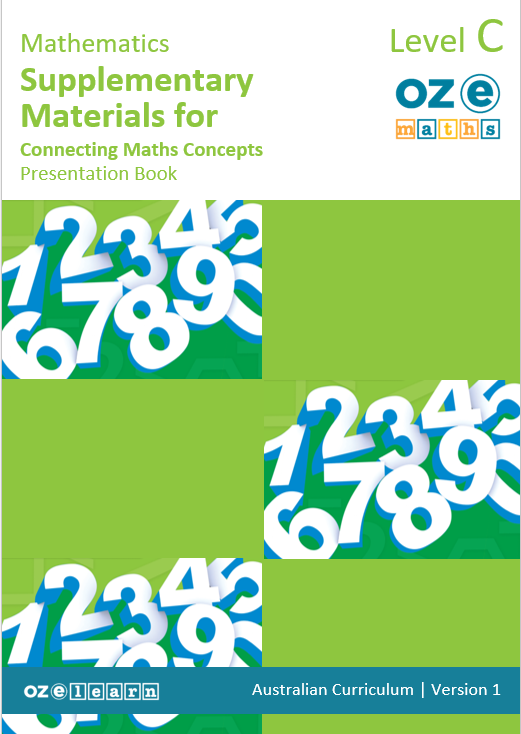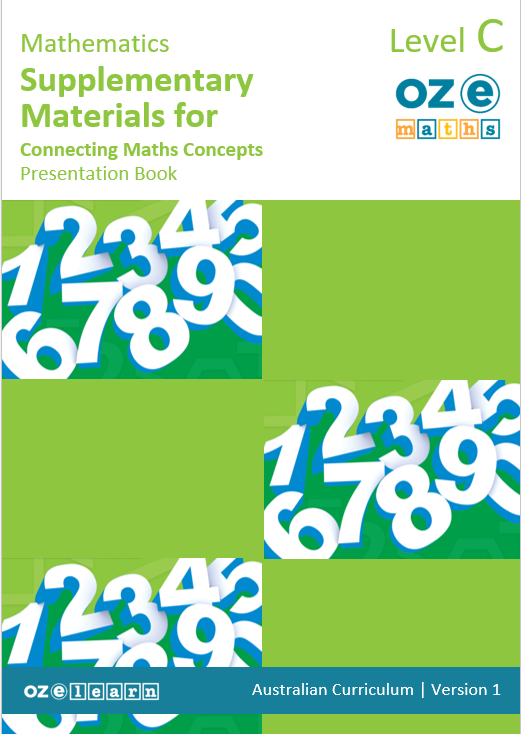Oz-e-maths Supplementary Materials for Connecting
Math Concepts Years F-5
Top-ups and Swap-outs for Currency and
Measurement – Year 2
Overview
Top-ups and Swap-outs for Currency and Measurement – Year 2 is a Mathematics unit for Year 2 students.
It works in cooperation with Connecting Maths Concepts (CMC) to ensure that delivery of CMC aligns with Australian Curriculum gap requirements. It aligns to the Australian Curriculum:
- Measure the length of shapes and objects using informal units, recognising that units need to be uniform and used end-to-end (AC9M1M02)
- Describe the duration and sequence of events using years, months, weeks, days and hours (AC9M1M03)Group, partition and rearrange collections up to 1000 in hundreds, tens and ones to facilitate more efficient counting (ACMNA028).
- Group, partition, rearrange and rename numbers up to 1000 according to their place value and into other number groupings (AC9M2N02).
- Recognise and explain the connection between addition and subtraction as inverse operations, apply to partition numbers and find unknown (AC9M2A01).
- Count and order small collections of Australian coins and notes according to their value (ACMNA034).
- Measure the length of shapes and objects using informal units, recognising that units need to be uniform and used end-to-end (AC9M1M02)
- Describe the duration and sequence of events using years, months, weeks, days and hours (AC9M1M03)
- Group, partition and rearrange collections up to 1000 in hundreds, tens and ones to facilitate more efficient counting (ACMNA028).
- Group, partition, rearrange and rename numbers up to 1000 according to their place value and into other number groupings (AC9M2N02).
- Recognise and explain the connection between addition and subtraction as inverse operations, apply to partition numbers and find unknown (AC9M2A01).
- Count and order small collections of Australian coins and notes according to their value (ACMNA034).
Lesson Objective
In Lesson 3 (CMC Level C: Lesson 31-40) students learn to:
- Know that two-digit numbers are comprised of tens and ones.
- use pictorial MABs to demonstrate that three-digit numbers are comprised of hundreds, tens, and ones/units.
- show that three-digit numbers are comprised of hundreds, tens, and ones/units.
- demonstrate three-digit numbers are comprised of hundreds, tens, and ones/units.
In Lesson 4 (CMC Level C: Lesson 51-60) students learn to:
- Describe skip counting and the pattern of counting by 2s.
- Use counting by 2s to count a collection of objects.
- Represent skip counting by 2s on a number line, identifying the missing number.
- Describe the 2s skip counting pattern beyond 100.
- Describe the pattern of skip counting by 5s.
- Use skip counting by 5s to represent the pattern.
- Use skip counting by 10s to represent the pattern and identify the missing number.
In lesson 5 (CMC Level C: Lessons 91-100) students learn to:
- Describe the effect of a one-step slide.
- Identify a one-step slide.
- Describe the effect of a flip.
- Identify a flip or slide.
- Investigate the effect of flips by moving and drawing shapes.
- Demonstrate the effect of slides and flips by drawing irregular shapes.
In Lesson 6 (CMC Level C: Lesson 101-110) students learn to:
- Identify and describe half and quarter turns.
- Demonstrate a half turn and quarter turn to create a pattern.
- In the Swap Outs students learn to:
- identify and count Australian coins
- apply ruler skills to measure length
- use a ruler to count backwards
- to solve comparison word problems.
Success criteria
Top-Ups
- Identify and describeflip and slide.
- Identify and describe half and quarter turns to create a pattern.
- Use skip counting by 2s, 5s and 10s to count a collection of objects and create patterns.
- Understand two-digit and three-digit numbers place value.
Swap-Outs
- Identify and count Australian coins
- Apply ruler skills to measure length and count backwards
- To solve comparison word problems
Assessment
Mastery Test
Mastery Tests are given at the end of every 10 lessons, designed to be taught over a two-week cycle. Mastery Tests allow teachers to monitor student understanding of the concepts taught in previous lessons and to identify where reteaching is needed.
The Teaching Guide contains the Mastery Test script. Mastery Tests are delivered using a presentation script, board displays and a handout for students. The Teaching Guide also contains the Answer Key.
Cumulative Tests
There are two Cumulative Tests for Swap-Outs that are completed after lesson 60 and lesson 120. The Cumulative Tests are in the Teaching Guide. Teachers copy the assessment and distribute to students at testing time.



